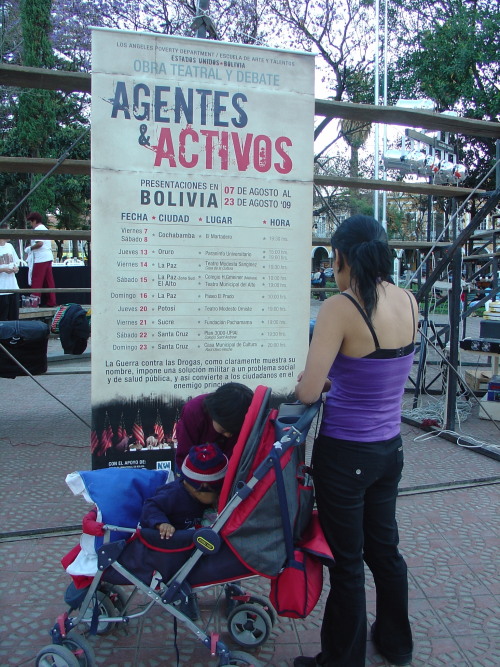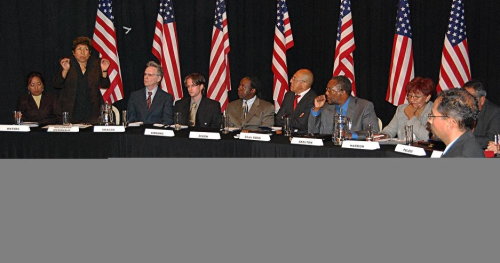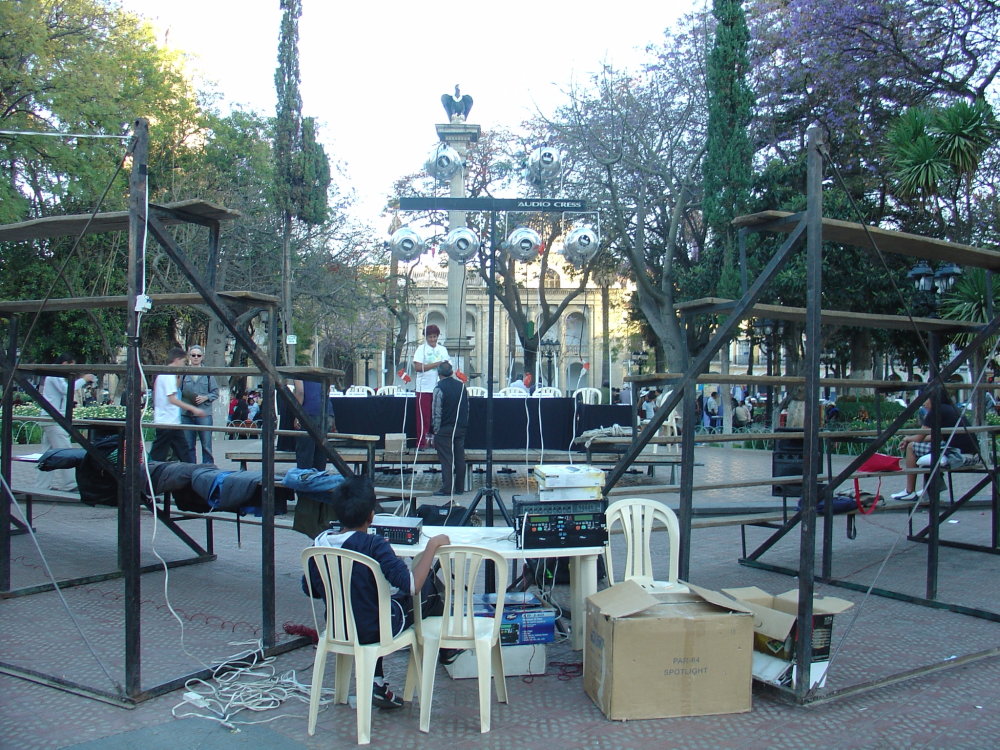The LAPD does Drug Show in Bolivia
October 20, 2009 • 6 minute read
By Elizabeth Doud, with John Malpede
One of the Performing America Projects’ Creative Exchanges that took place over the summer was the Los Angeles Poverty Department’s (LAPD) four-week trip to Bolivia. This residency was born out of LAPD Director John Malpede’s desire to take his company’s project Agents and Assets out of the United States and present it to communities in Latin America that had also been affected by the “war on drugs.” This piece (titled Agentes y Activos in its Spanish translation) is based on the 1998 transcripts of the U.S. House Intelligence Committee and the committee’s examination of allegations that the CIA was complicit in the crack cocaine epidemic that ravaged minority communities in California cities and elsewhere in the United States. The artist’s goals for this month-long residency were to create a productive working relationship between Bolivian and U.S. artists and to develop a project totally in Spanish, which they accomplished in partnership with their host in Cochabomba, Bolivia, La Escuela de Arte y Talentos directed by Wiler Vidaurre.
In the U.S., LAPD has presented this work with cast members who themselves have suffered the affects of addiction, incarceration and disenfranchisement as a result of the crack cocaine epidemic. For this exchange, the company focused on setting the work on Bolivian actors who would present the Spanish version of the work alongside several actors from LAPD. The piece then toured to five different cities in Bolivia, each performance followed by a panel that discussed the work and its subject in a community setting.
The relevance of doing this particular project in Bolivia is that the similar events were unfolding there simultaneously with events in the U.S. Rafael Puente, a Bolivian historian, activist and ex-government official who also acted as a post-performance panelist for the shows, pointed out to audiences that in 1980, the CIA enabled the violent narco golpe de estado (drug coup) of General Luis Garcia Meza, and that Bolivia had also suffered what writer and LAPDer James McEnteer calls the “hypocrisy of lawmakers who decry illegal drugs, even as they refuse to sanction the government agencies that enable millions to become traffickers and addicts.”
The Creative Exchange component of NPN’s Performing Americas Program supports a wide range of projects, and allows artists to build on interesting connections and nascent partnerships that might not otherwise be developed into more concrete and meaningful projects, such as Agentes y Activos in Bolivia. In looking at the ways the amazing range of projects have been successful, we are always curious about how the initial connections are made.
The idea of an international creative exchange is interesting to most artists, but often they feel like they don’t know where to begin to find a host, especially if they don’t have an immediate connection with someone in another country. John Malpede offered some background and details on his Creative Exchange process. We asked John to describe how he came to partner with his host in Cochabamba:
“We’ve long had the idea of bringing together victims of the ‘war on drugs’ here and in South America. Jim McEnteer, who’s writing a book on LAPD, is living in Cochabamba, Bolivia. In September 2008, the Amsterdam-based Trans-National Institute that works on world drug policy convened a conference in Cochabamba — we went and made the connections that eventually led us to Wiler Vidaurre and his wife psychologist and actress, Zulma Galvan. Wiler and Zulma had done theater in the prisons in Cochabamba for eight years, so we were very interested in meeting them.”
Many of the PAP Creative Exchanges start out with an artist’s curiosity in a specific culture or issue, and eventually lead to the connection to the host. One of things that many artists see as an insurmountable obstacle to taking theater to another country is the language barrier. For artists whose work is primarily text-based, as is the case with LAPD’s project, the translation, much less the performance, of the work in another language can seem almost impossible. There are many ways to approach this problem, and John elaborated on the value of doing the work in Spanish brought to the overall experience:
“Performing the entire show in Spanish was a big challenge for LAPD, but one that was deeply appreciated by our Bolivian collaborators. They were amazed that we could pull off learning difficult text and pronouncing it in Spanish that was understandable to Spanish speakers. They also interpreted our effort as evidence of our sincerity (when it was challenged) mostly because of where we come from — the U.S.A. Our set consisted of 13 American flags behind a Congressional hearing table. An audience member asked if the purpose of the flags was ‘intimidation or irony.’ In other words, we had to contend with the legacy of the U.S. in Latin America, and couldn’t assume that our critical inquiry would be regarded as such by Bolivians.”
In preparation for their trip, the company offered the cast Spanish lessons. This experience has created new relationships within the L.A. Spanish-speaking community, and they now find that they have expanded their ability to do outreach in Spanish in the Skid Row area where the company works. “We made new connections with Latino communities in and outside the U.S. In preparation for this residency we asked one of the women who participated in another LAPD production, La Llorona, Weeping Women of Echo Park, to teach us Spanish. This gave LAPD the opportunity to learn about the situation of immigrants in the U.S. and Latino culture.”
Besides the obvious goal of creating opportunities to travel and work abroad for artists, as well as broadening the international artistic exchange in this hemisphere, the Performing Americas Program has other subtle and harder-to-plan outcomes that circle back to the real meaning of cultural exchange. We asked John what he thought was most successful about their experience:
 “We presented the production in a wide variety of circumstances: from prisons, to municipal theaters, and central plazas to universities and high schools. The Bolivian audiences made all kinds of links between the reality there and the issues raised in the performance. We created opportunity for dialogue. People were supportive, and in some cases astounded, to meet Americans with an independent perspective. We learned that demonization of the other is prevalent: Bolivians blaming the users in the North, while the American war on drugs policy is predicated on the assumption that it’s not our fault that we have a drug problem — that’s why we go forth and eradicate. We learned that in both countries, it’s not the kingpins, but the little people, the users, the mules that fill up the jails.”
“We presented the production in a wide variety of circumstances: from prisons, to municipal theaters, and central plazas to universities and high schools. The Bolivian audiences made all kinds of links between the reality there and the issues raised in the performance. We created opportunity for dialogue. People were supportive, and in some cases astounded, to meet Americans with an independent perspective. We learned that demonization of the other is prevalent: Bolivians blaming the users in the North, while the American war on drugs policy is predicated on the assumption that it’s not our fault that we have a drug problem — that’s why we go forth and eradicate. We learned that in both countries, it’s not the kingpins, but the little people, the users, the mules that fill up the jails.”
This project is a perfect example of how artistic exchange among peers and communities can do the hard work of international diplomacy where governments fail.
The Performing Americas Program (PAP) is in its seco
nd phase of the Creative Exchanges and supporting residencies for the 2009-2010 period. The Creative Exchange initiative is intended to create a deeper engagement for the community and artist, and can — but doesn’t necessarily — result in a performance of any kind. Through this initiative, PAP has funded Latin American/Caribbean performing artists and arts professionals conducting residencies at NPN sites, and U.S.-based performing artists and arts professionals conducting residencies in Latin America and the Caribbean. The Creative Exchange model is flexible by design, allowing participating organizations to exercise their creativity in structuring projects. Residencies can support, for example, intensive technique workshops and master classes, arts administration and technical theater seminars, the setting of a work by the residency artist on a host company or a group of local artists, or just creating work. Activities such as master classes, lecture demonstrations, and workshops are considered standard practices. Projects may also involve collaborations with other arts and community-based organizations that have parallel institutional purposes. This Creative Exchange not only received support from PAP, but also from the City of Los Angeles’ Department of Cultural Affairs who matched the funds PAP provided for this L.A. based artist.
Elizabeth Doud is the Project Coordinator for NPN’s Performing Americas Project. Based in Miami, she is also an interdisciplinary performing artist, writer, and educator.
John Malpede is the Artistic Director of LAPD, which he founded in 1985. He is also a performance artist, actor, writer, and educator.
photo credits: Henriëtte Brouwers, Associate Director of LAPD
The Community Fund is made possible by the Doris Duke Charitable Foundation, the Ford Foundation, the National Endowment for the Arts (a federal agency), the MetLife Foundation, and the Nathan Cummings Foundation.
published October 2009